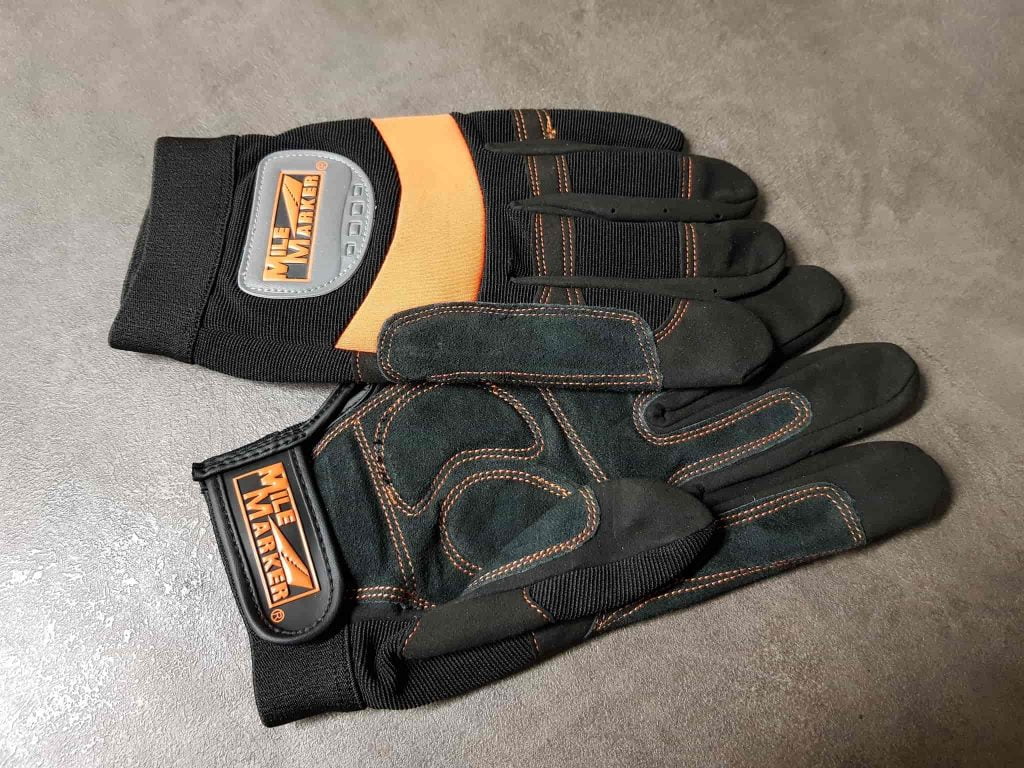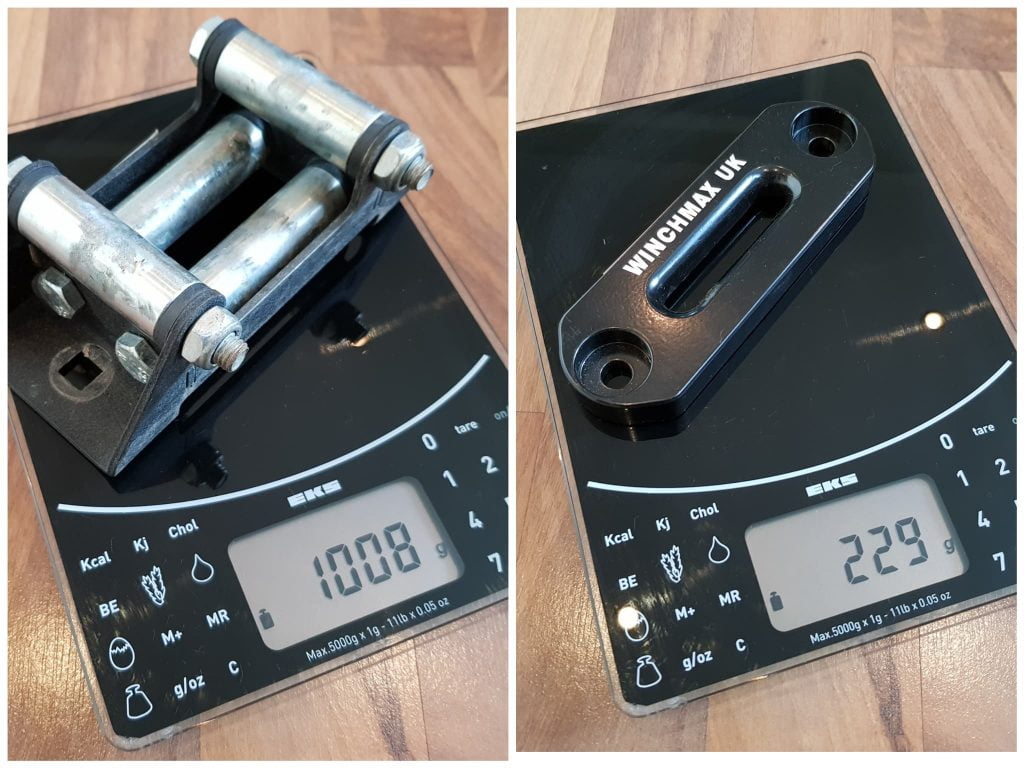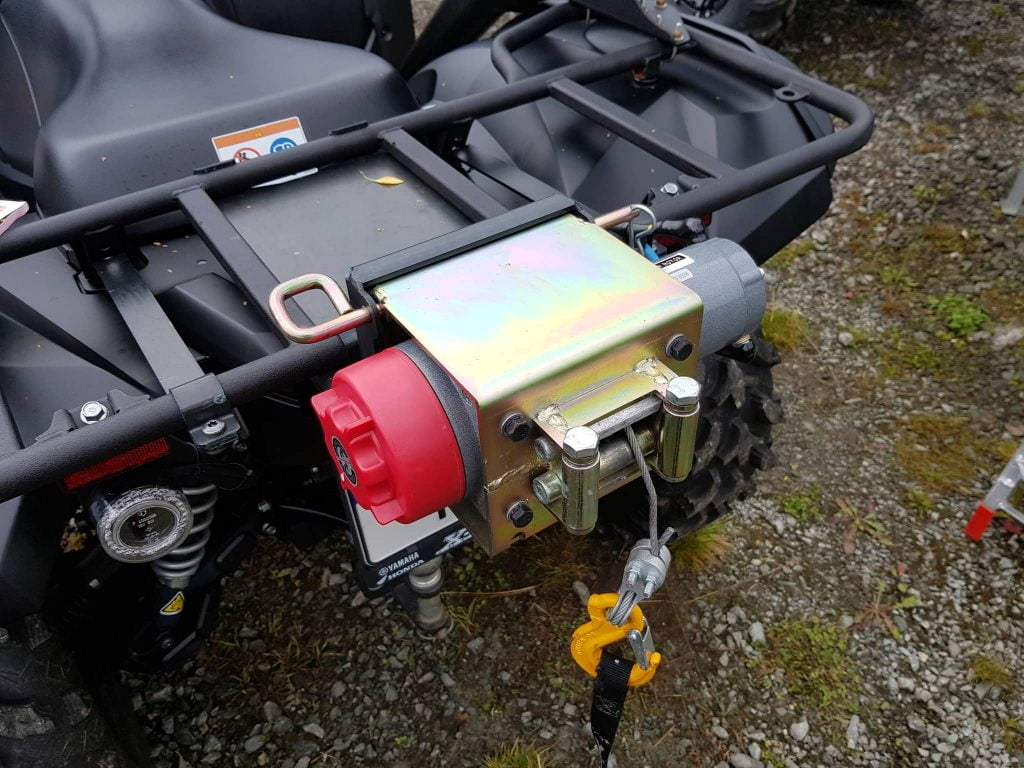I’ve gathered 17 of the most helpful accessories for your ATV winch. You may not need all of them; some are in the “nice to have” category, while others are absolute lifesavers.
Tree Trunk Saver and D-Shackle
Let’s begin with an essential accessory for anyone who owns an ATV winch. If you don’t get one, you will likely make one of the most common rookie-winching mistakes.
And that is looping the winch rope or cable around a tree and hooking it back onto itself. Doing so gives you a solid anchoring point, but it is not the proper way of anchoring a winch rope.
Related: How to Winch an ATV: A Step-by-Step Guide
I’ll be the first to admit I have also made this mistake simply because I didn’t know better.
The correct way is to loop a tree-saver strap around the base of a solid tree trunk and then hook the winch cable to the strap. Use a D-shackle as a connector between the strap and the hook, and you have a rock-solid anchoring point.
The purpose of using a tree strap is two-sided:
- It saves the tree from damage.
- It protects your winching cable from premature wear.
The strap should be about one to two inches wide. A flat and wide strap will not dig into and damage the tree as your round winch cable would. This is simply due to having a larger surface area in contact with the tree trunk.
Some riders don’t consider the occasional scuffed-up tree trunk a big deal. But it is. Not only because of the actual damage you do to the tree but also the damage you do to all other ATV riders’ reputations.
Leaving scarred trees may be what causes the next ATV trail to be closed or prevent a new one from being opened.
Another good selling point for using a tree strap is how it keeps your winch cable from fraying.
If you loop the cable around a tree and hook the winching hook back onto the cable, you will prematurely wear or possibly damage the part of the rope that comes in contact with the tree and the steel hook.
On the other hand, the tree strap is more robust and will not wear as fast. It is also much cheaper to replace when worn instead of replacing the entire winch cable.
The shackle or D-rings give you a more robust and safe way of hooking up to your anchoring point.
Snatch Block
A proper snatch block is one of the most versatile and helpful winching accessories. It comes with a range of benefits and uses, such as:
- Allows you to double or triple the pulling capacity of your winch.
- This not only makes your winch more powerful; it reduces the stress on the winch motor and gears, which may expand the life expectancy of your winch.
- You can use a snatch block to change winching direction when needed. Changing the course of the winch rope is useful to reach solid anchoring points, winch around objects, or prevent damaging your winch rope by winching over sharp rocks.
Ensure the snatch block you get is designed to be used with your winch rope type. Some pulley wheels are made to be used only with steel cables and will wear or even damage synthetic winch ropes.
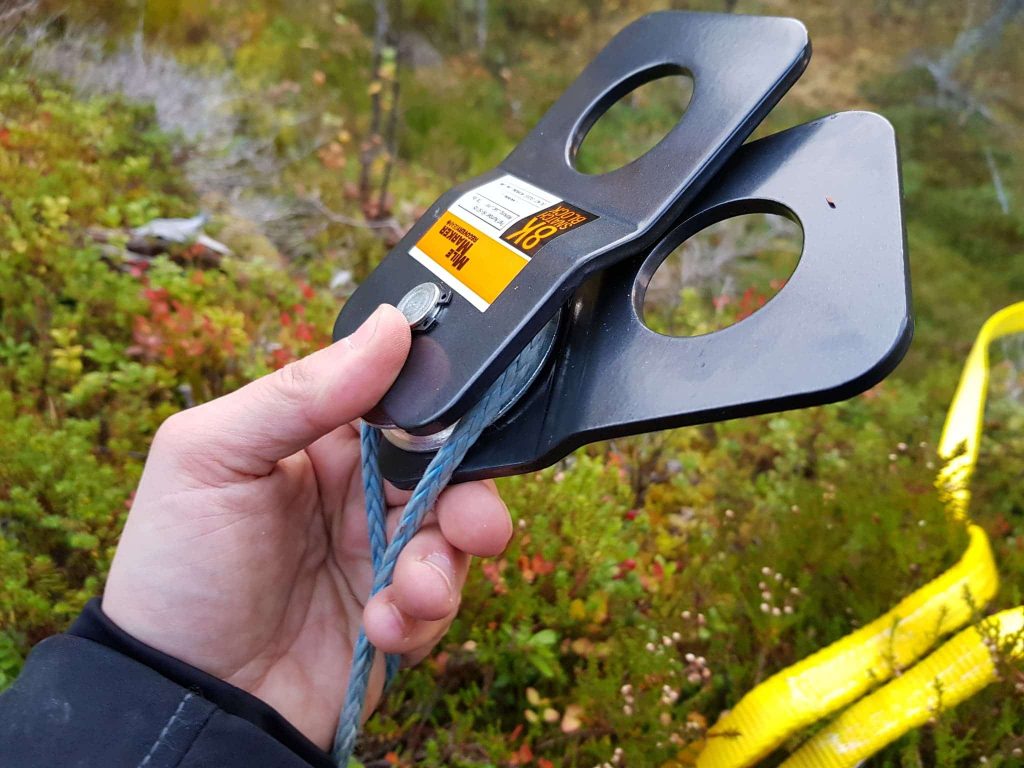
Heavy-Duty Leather Gloves
If your ATV winch is fitted with a steel cable, you will need a pair of heavy-duty leather gloves whenever you handle the winch cable.
Steel cables have the downside of beginning to develop small burrs or splinters as they wear, a process known as fraying. These small steel splinters can cause severe hand injury if you do not protect them adequately using beefy gloves.
Synthetic winch ropes may also fray when they wear, but they won’t hurt your hands, making gloves less critical when using this type of cable. However, you still risk friction burns, so using gloves is always a good idea, regardless of what kind of cable you have.
Synthetic Winch Rope Upgrade
Upgrading your steel cable to a winching rope made from synthetic material will drastically reduce the chance of hurting your fingers when handling the rope.
Safer and more comfortable handling is just one benefit of a synthetic winch rope. They also come with other cool perks, such as less weight and higher breaking strength.
Look for a rope with a protective sleeve and a connector loop with a metal insert.
Read about all the other benefits of a synthetic winch rope in this post, where I look at the pros and cons of both steel cables and synthetic ropes.
Aluminum Hawse Fairlead
With a synthetic winch rope, you can replace your steel roller fairleads with an aluminum hawse. They are more gentle on the synthetic rope than the steel rollers and significantly lighter.
Reverse Winching Kit
Most ATVs have the winch permanently fixed at the vehicle’s front end. That’s where you’ll need it to be most times, anyways.
When you ride in the mud where there is a risk of getting stuck, you should always plan to have a tree in front of you where you can hook up your front winch.
But things do not always go as planned. You get stuck, and there is just more mud in front of you. There may be a big tree behind the ATV, but no way to reach it with the front-mounted winch.
Installing a rear winch permanently is one option, but on many ATVs, you’ll have difficulty finding a good spot where it won’t be in the way.
A reverse winching kit uses a set of pulleys that allows you to direct the winching rope or cable down and under the ATV. This way, you can use your front-mounted winch to pull the ATV backward out of the mud.
It may not be for everyone, but if reverse winching is vital to you, it may be worth checking out.
Removable Rear-Mounted Winch
As an alternative to permanently installing a winch at the rear of your ATV, you can get a detachable unit that you hook up only when you need it the most.
Some models connect to the hitch receiver, while others hook up to the rear cargo rack/frame.
Mobile Winching Anchor
You will need a mobile winching anchor if you do a lot of dune riding with just sand and no trees around to use as an anchoring point. This accessory is even more essential if you ride alone, with no one to hook on to if or when you get stuck.
A winching anchor works by digging a flat piece of metal into the soft ground. Then you hook your winch hook to the anchor.
The large anchor surface will distribute the pulling power over a larger area of the softer ground. Hopefully, there is enough holding power to get you unstuck.
Aluminum Winch Shackle Connector
Upgrade your standard winch hook to an aluminum winch shackle to get a stronger, lighter, and safer connection to your anchoring point.
The aluminum connector is fixed to the winch rope with a steel pin. At the other end, you have a hole where you can hook up a D-shackle and a winching strap.
These connectors fit both synthetic ropes as well as steel winch cables.
Winching Accessory Kit
You can get several items discussed in this post as complete kits. The kits vary in content and quality, but you usually get what you pay for. These typically contain gear such as:
- Tree saver
- Pulley block
- A couple of shackles
- Gloves
- Maybe a tow strap for towing your buddy home.
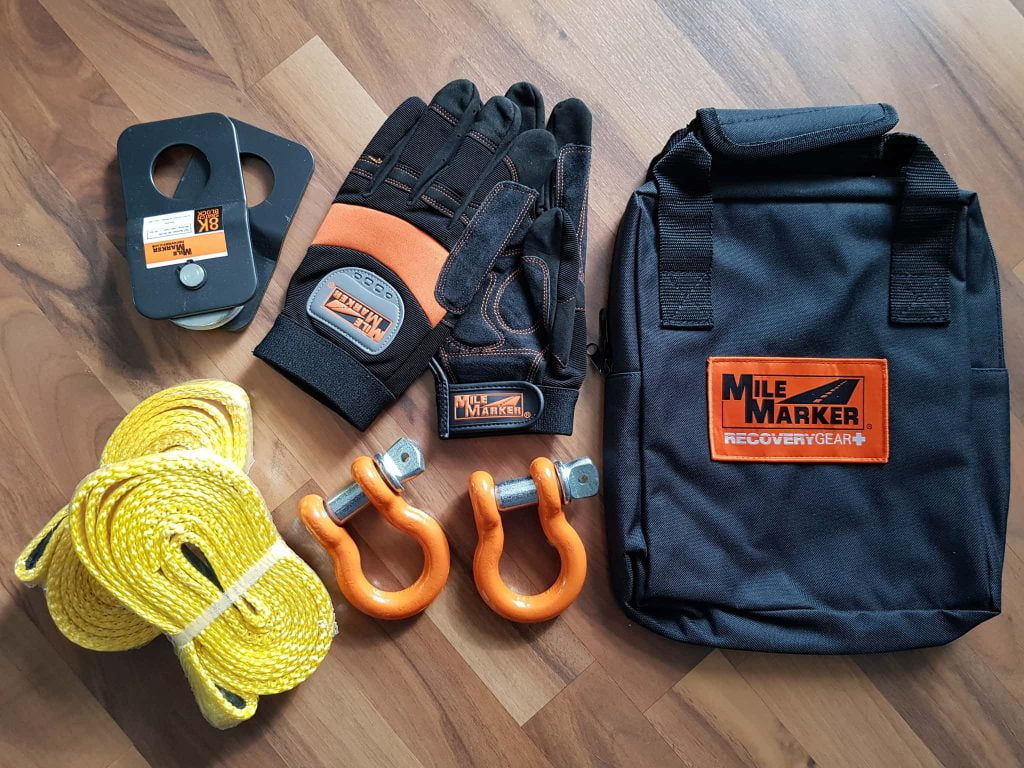
Do not cheap out and get the cheapest stuff out there. The quality of the cheapest ones can be questionable.
And if branding is not that important to you, you won’t get that much better product by paying top dollar for the market-leading brands, either.
There is a lot of good stuff to choose from in the medium price range. I’ve included my favorite kit on the recommended products page.
Winch Cable Rubber Stopper
A rubber stopper is just what it sounds like. It’s a two-part rubber ball that attaches to the cable a few inches from the winch hook.
Its purpose is to stop the cable just before the winch hook reaches the fairlead.
This will protect the towing hook and your fairlead/hawse from dents and rattles from being winched into each other. It also keeps tension on the cable, preventing it from coming loose.
Wireless Remote Kit
From time to time it depending on the situation, it is nice to have the ability to operate the winch remotely.
But the remote that comes with stock winches is usually wired or with no remote, just a rocker switch.
Some brands offer wireless remote upgrades for their winches. Or, you can get a universal kit provided by companies like Cabelas and others. The universal kits will work with most ATV winches on the market.
Look for a model that automatically powers off when not using the remote. It’s easy to forget to turn off a manual switch, resulting in a drained battery.
Wireless winch remotes left in the ON position will draw a small current from the ATV battery. This is, in fact, a widespread cause for ATV batteries that keeps draining.
Here is a full guide to troubleshooting an ATV battery that keeps going dead.
Extra-Long Grab-Strap
This one could be beneficial for all the mud bashers out there.
Most winches have a tiny 12-inch grab strap attached to the winch hook. You’re supposed to grab onto this strap when you pull on the winch cable.
The problem with the stock strap is that it usually gets lost after just a few times use, which is way too short.
If you’ve ever found yourself waist-deep in mud or water, you know what I’m talking about. Digging into the mud looking for your winch hook is not that fun.
With a 2-3 feet long grab-strap, you can tie the free end to your front cargo rack, and you will get to your winch hook without getting wet and muddy.
You can make one yourself or get one from the store. It doesn’t matter how you make it; even a short piece of rope will do.
Log Grapple (Lifting Tong/Log Hook/Skidding Tongs)
They have many different names but all work by the same basic principle. It’s a simple log-gripping tool that hooks up to the end of your winch cable. Two metal hooks tighten by the force of the pulling winch cable.
Place the hook around the end of a log and winch. The hooks will tighten and grab the log fast and easily.
You can use it to retrieve hard-to-reach logs, skidding, or for lifting when you use your winch with an ATV log trailer with a crane.
The tool is much faster and more practical than messing around with straps or chains.
Choker Chain
A so-called choker chain is a short piece of chain, about 4-5 feet long, that can attach logs to your winch cable.
They have a ring at one end that allows you to loop the chain around the log. The chain will tighten around the log as you pull on the winch cable.
They are not as fast to hook up as a log grapple but still handy, everlasting, and cheap.
Their robustness and failproof operation make them my favorite log attachment tool for any log winching application.
If you are looking for creative ways to use your ATV winch, you will find 29 ideas for winch uses in this post.
Kinetic Recovery and Tow-Rope
You should never use your winch rope to tow another vehicle. Doing so will likely damage the gears inside your winch.
Also, please do not fall for the temptation of hooking the winch rope to a stuck ATV and then trying to pull it out by driving your bike.
Yanking on the winch rope will more than likely do permanent damage to the inside of your winch.
Instead, you should use a kinetic recovery rope whenever you try to get an ATV unstuck by pulling instead of winching.
A kinetic recovery rope is a slightly stretchable rope designed to recover vehicles stuck in sand, mud, or snow. The stretch will take up much of the energy created by pulling hard on a stuck vehicle, creating much less strain on both vehicles’ anchoring points.
You can also use the rope to extend your winch rope any time you lack a few feet to reach the nearest tree.
I find them to be an excellent winch saver and a multi-purpose rope to extend the reach of my winch.
Hitch Receiver D-shackle mount
If your ATV does not have a proper rear anchoring point, consider installing a D-shackle mount to the hitch receiver. This will make a solid point to hook up the winch hook next time your friend will be winching you out of the mud.
Wrapping Up
As you venture into the great outdoors, remember that the right accessories can make your ATV winch experience safer and more enjoyable.
From protection to convenience, the value these 17 essentials add is immeasurable. Explore, prepare, and ride on, knowing you’ve got the best gear on your side.



